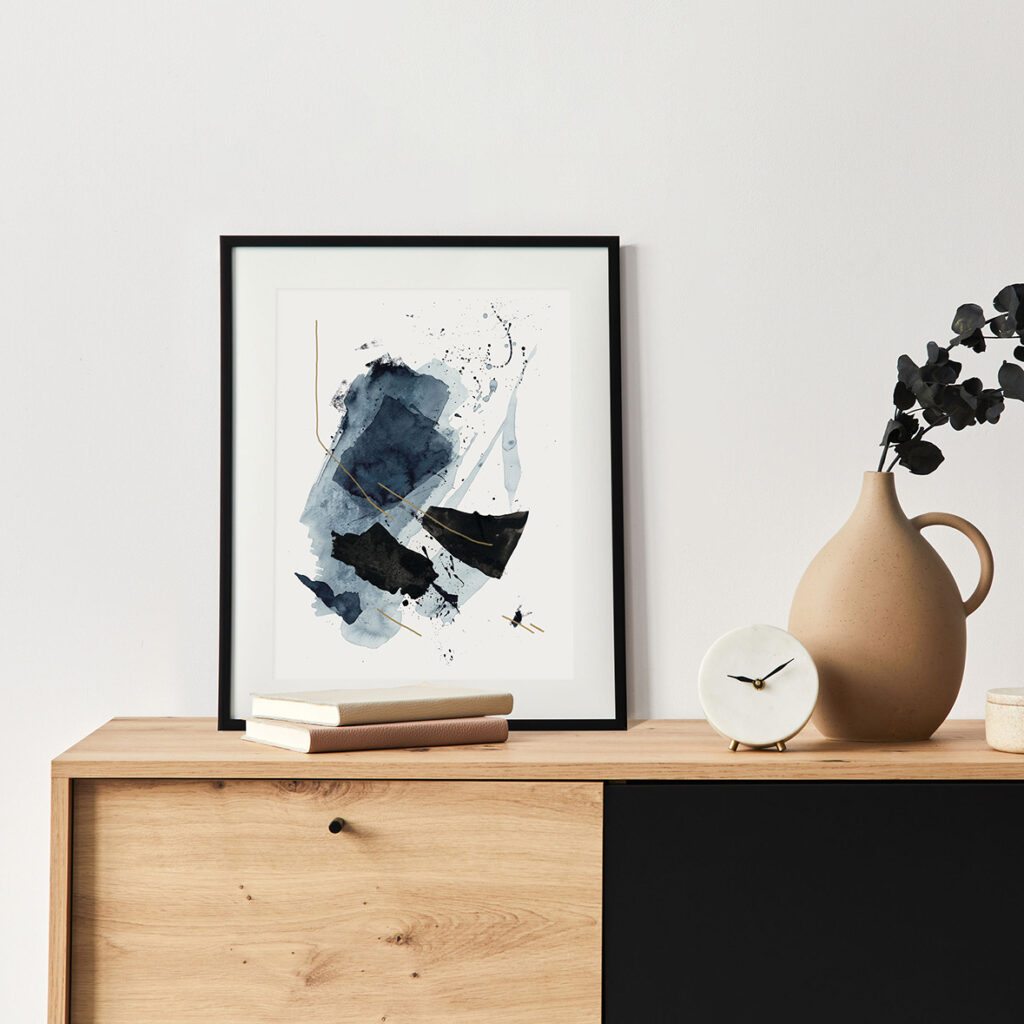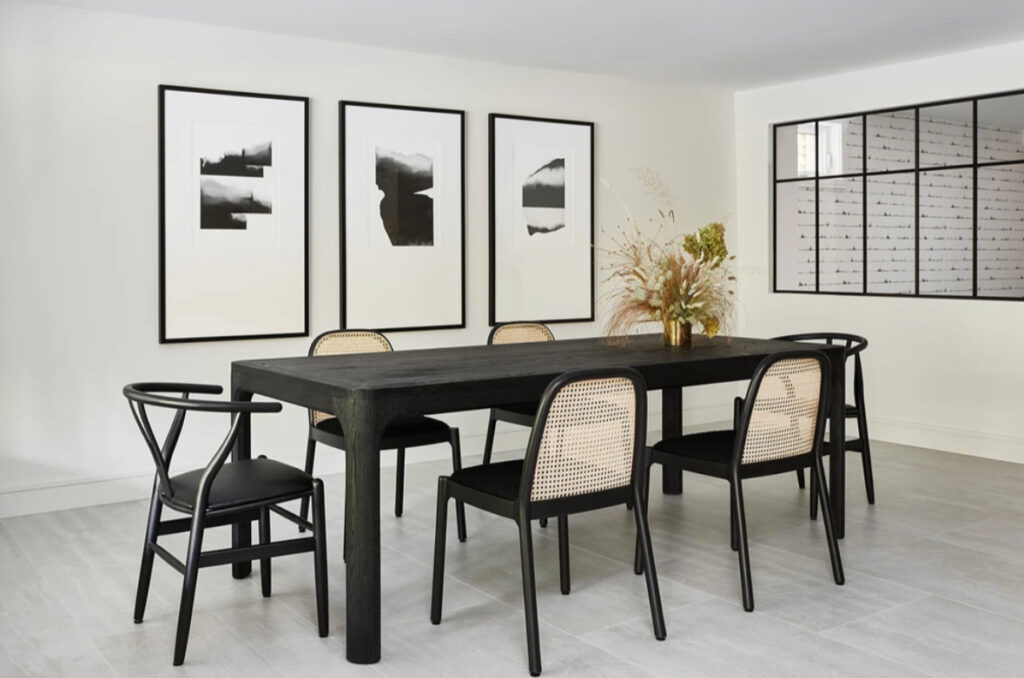Tranquil Escapes: Meet Abstract Artist Kim Knoll
From The Ritz-Carlton to Norwegian Cruise Lines, Kim Knoll’s work has found its way into some swanky locations. While her success as an artist came relatively quickly — within a year of pursuing painting — it was built on a solid foundation. The 19 years Kim spent as a graphic designer before turning to fine art significantly shaped her distinctive abstract style.
A Meditative Mindset
Based in Chicago, Kim balances city life with an affection for the great outdoors. She connects the two through her work, infusing minimalism into moments of natural beauty involving sea, sky, and unique terrains. Using watercolors, acrylic, ink, spray paint, charcoal, and graphite, Kim conveys emotion and meaning through gestures and marks. Her goal? To create art that gives the viewer a welcome escape from everyday worries.
Enter Frame Destination
The works on paper Kim shares with us (“Letting it Go,” top photo below; and a triptych including “Clouds,” “Making Memories,” and “Into the Wild,” bottom photo below) are all framed in our Nielsen Picture Frame Arthaus Style 117. This aluminum frame embodies the essence of balance, clean lines, and refined proportion typical of the influential Bauhaus movement of the early 20th century. Kim chose a Black finish, but other colors include Frosted Silver, Bright White, and Frosted Gold. She especially appreciates the simplicity of ordering custom frames through our website, making it easy to showcase her work with the finesse it deserves.


See More of Kim’s Work
Discover Kim’s artistic fusion of urban energy and natural serenity at KimKnoll.com. In the "Journal" section, you can explore her creative process, from brand collaborations to her favorite mark-making tools. Kim’s Instagram shares moments in nature that inspire her art as well as her first works on canvas (see her 5/3/24 post). Curious how Kim made the leap from graphic designer to full-time artist? Our Q&A below delves into that and more.

Now for Artie’s Eight Q&A with Kim Knoll…
1. What is your background; how did you get started?
All I wanted to do as a kid was draw and color. I entered every coloring contest I could. I drew my own coloring books. I joined an extracurricular art school where I was trained in perspective and drawing, alongside art classes at public school. My high school art teacher said if I wanted to make a living doing art, I should be a graphic designer. I trusted his advice and forged a path in graphic design, graduating from a university with that degree. I spent the next 19 years as a professional graphic designer with 11 of those years leading my own branding and design studio. In 2016, I was working on a new branding project and wanted to use watercolor washes as a texture in their visual identity, so I bought the supplies and dove in. I was hooked — I loved everything about it! So, I bought more supplies and pursued painting as a personal project. At this same time, I was growing tired of sitting in a chair and staring at a screen all day. Within just a couple months, people were buying my paintings through social media. Knowing people wanted to buy them, my husband and I built a website for my paintings over a weekend. After splitting my time between painting and design for years, I was fortunate enough to choose painting as my full-time focus, so my husband and I closed the doors to our branding and design studio. I have no regrets!
2. What role do you think the artist plays in society?
I think an artist's work reflects society. Everything the artist absorbs from their everyday life is captured in their art through emotions, depictions, expressions, concepts, etc. and it provides a mirror for people to feel, see, and contemplate their lives. There's a power in art that lets people connect with their feelings, fostering empathy and understanding and even change. Artists contribute to the evolution of culture and society by introducing fresh perspectives and challenging the status quo.
3. What has been a formative experience or the best advice you’ve received within your career?
There are two pieces of advice that I often refer to. Here’s the first: "Take the word 'new' out of your vocabulary." Since I've been trained as a graphic designer and lived it for so many years, it's ingrained in me to make something completely different and “new” each time. With branding, you can't ever repeat what you've done for someone else — ethically or legally. When I would finish a project, I would turn that part of my brain off and explore new directions, visuals, etc. With painting, it's the complete opposite. You want to continue down the same path and create pieces are familiar or have a thread that runs through them for a cohesive, consistent style. It's a struggle for me since I'm programmed to do the opposite. When I'm going to make a new painting, I no longer call it “new” in my mind, which helps me avoid feeling like I need to reinvent myself. I simply just make another painting. The second piece of advice is this: "Create art that you would hang in your own home." Sometimes I can start heading in a direction that doesn't feel like me. It will have all the elements that I like or feel like other paintings I've done, but there will be something about it that isn’t right. I was on Instagram one day and an artist was talking about how they always hang their finished painting in their own home and live with it for a week or two before they sell it. It's such a simple and basic idea, but a light bulb went off for me. If I wouldn't hang it in my own home, then that's when I know I'm going down the wrong path and it's time to get back on course.
4. In what ways does your work reflect your personality?
I'm a curious person who is mostly quiet, observing everything around me. Being a Scorpio, I also have a bit of an edge or a bite to me, ha ha. I think this is reflected in my work. I try to create contemporary paintings that are tranquil with an interesting take. Plus, the colors I use in all my paintings match my closet pretty spot on.
5. Creative blocks, do you get them? If so, how do you overcome them?
Of course! I usually get them when I've been focusing on the business side of things and haven't painted in a few weeks. The best way for me to overcome blocks is to study my past work and look at my folder of inspiration that I keep updated. It's like I have to submerge my brain in nothing but that for a couple days and get out my iPad to sketch ideas. When I'm really frustrated, I'll just throw some paint on the paper without any thought behind it, and then it becomes a fun challenge for me to figure out the next layer, and the next, until it's done.
6. What is your most indispensable tool? (Not counting the obvious, like paints, brushes, canvas, camera, etc.)
My iPad Pro. It is such a big part of my process that I could never be without one. A lot of my creativity comes out on the iPad. It's a great way for me to explore ideas without committing to any of them. The iPad isn’t a precious piece of paper that I've taken the time to cut and stretch, and that allows me to have more freedom of expression without any fears of ruining it.
7. Do you have a new project you are working on, or a new passionate idea?
I’ve been working on a large scale for a while, so I’m feeling the need to challenge myself and work on a collection of small paintings, around the size 8”x10”. I also want to explore more color schemes that are new to me, so I’ll be using this as an opportunity to do that. I’m not sure what the concept will be yet, but I’m sure it will come to me when I least expect it!
8. What is your favorite color to incorporate into your art?
Black. It’s everything.
ARE YOU READY FOR THE SPOTLIGHT? Simply respond to the questionnaire here to apply to be included in an upcoming Artie’s Eight Spotlight.
Last Updated August 20, 2024